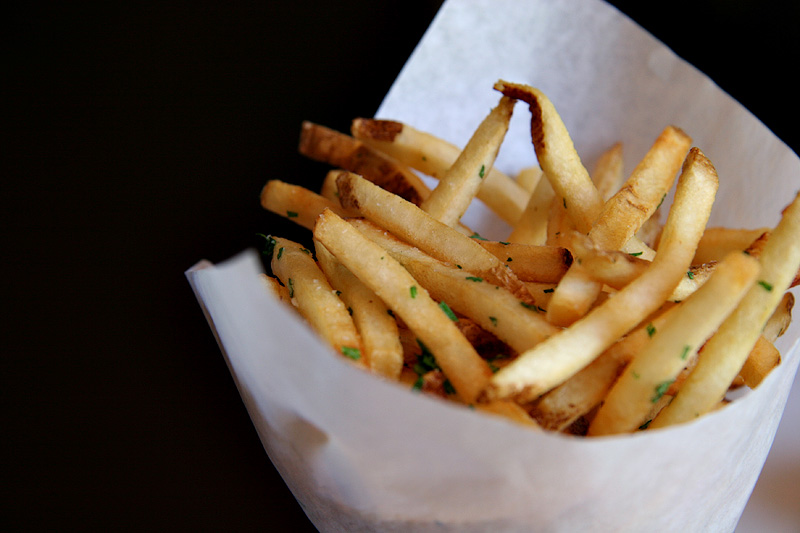 Michael Tonsmeire is a homebrewer and fermentation nerd living in Washington, DC.
Michael Tonsmeire is a homebrewer and fermentation nerd living in Washington, DC.Most people love a good beer, but what really goes into making a beer anyway? Sure most people know malt and hops are important, but is that it? With the huge number of microbrews and imports available these days, walking into a well stocked beer aisle can be almost as intimidating as trying to pick out a wine. There are no ingredient lists on the bottles or six packs so how are you supposed to tell if any of them contain refined sugars?
Even though most people drink beer, few people really know how barley and hops end up as an alcoholic liquid. Whether you are brewing a 5 gallon batch of Russian Imperial Stout at home or a 500 barrel batch of Light American Lager at a mega-brewery the general process is the same, even if the equipment and scale are completely different.
Malted (sprouted then dried) barley is crushed, then mixed with hot water. The color and malt flavor of the beer are determined by the amount and type of specialty (roasted or caramelized) malts that are included. This mixture (called the mash) is held at 150 +/-8 F until the enzymes activated in the malting process break down the starches (made up of long chains of sugar molecules) contained in the endosperm. The majority of the resulting sugar is maltose, but glucose, sucrose, maltriose, and unfermentable dextrins are also created. By controlling the temperature of the mash the brewer can control the general distribution of the different types of sugar created (which in turn determines how sweet the resulting beer will be).
Next comes the sparge where more hot water is slowly added to the top of the grain to help rinse out more of the sugars as the sweet liquid is allowed to drain out the bottom. Along with the sugars, malt flavor, proteins, tannins, and nutrients are also extracted and washed into the brew kettle.
The sweet liquid (now called wort) is brought to a boil. Hops (a flower) are added at various points during the boil for their bittering and aromatic qualities. After a 60-90 minute boil the wort is run through a heat exchanger (to cool to ~65 F for an ale or ~50 F for a lager) and then into a fermenter. Yeast (a single celled fungus) and oxygen are then added to the wort. During the next 12 hours the yeast cells use the oxygen to help them to reproduce. Once the oxygen is used up the yeast switch to anaerobic mode and begin to ferment the sugars in the wort.

Fermentation creates energy for the yeast cells and produces ethanol and carbon dioxide as byproducts (the carbon dioxide is allowed to bubble out of the fermenter). Once fermentation is complete the yeast begins to clump together (flocculate) and fall to the bottom of the fermenter where it can be removed and added to a fresh batch of wort.
After 14-21 days fermentation will be complete and the beer will be pretty clear (lagers are then stored for a period of weeks or months at low temperatures to allow for the flavor to mellow further). At this point the brewery has several options on how to package the beer for sale. Many start by filtering or centrifuging the wort to remove any remaining yeast cells and haze causing proteins. To carbonate the beer the brewer has two options, force in carbon dioxide (in the same way a soda is carbonated), or introduce a small amount of fermentable sugar along with some fresh yeast to create natural carbonation.
This is how a basic beer is made. I don't have the space here to go into using fruit, herbs, spices, coffee, dry hops, honey, lactic acid bacteria, unmalted grains, or any other fun stuff. If you want to learn more about these topics check out
my blog.
Since the point of this article is supposed to be how refined sugars are used in brewing, I better get to it.
The good news for anyone looking to avoid refined sugars is that most commercial brewers don't use them. Most beers get all of their sugars for fermentation from the whole grains in the mash. In addition to the malted barley this can include malted or unmalted wheat, oats, rye, rice, and corn/maize.
There are some styles of beer which do have some refined sugar added to the wort. Belgian (and Belgian Style) beers are the most notable example. Many strong Belgian beers get 15-30% of their pre-fermentation sugar in the form of refined beet sugar (sucrose), although this sugar is often caramelized before it is added to darker beers. The sugar helps to lighten the body of the beer and improve drinkability. The good news is that the yeast selectively consumes sucrose and glucose before moving on to maltose and the more complex sugars. This may be one of the most important points for some of you, so I will quote George Fix from page 99 of
Principles of Brewing Science:
The elementary sugars glucose and fructose are generally the first to enter the yeast cell. They are followed by sucrose. Before entering the cell, sucrose is first inverted, or split, into glucose and fructose units by invertase.
...
Maltose is brought into the cell at a slower rate than glucose or sucrose. Maltose is transported intact into the cell by the maltose permease enzyme (maltase) and then split inside the cell into two glucose units by the enzyme β-glucosidase.
Some of the cheapest American lagers, malt liquors, and cream ales contain a large amount of corn syrup (up to 40% of their fermentables), but if you are the sort of person worried about consuming refined sugars I am guessing you don't drink a lot of cheap beer (I'm talking even cheaper than Bud/Miller/Coors which each contain corn or rice).
If a brewery wants to do natural carbonation (called bottle or cask conditioning if done in the serving vessel) the brewers can choose to add either a bit of unfermented wort or refined sugar (most often sucrose or glucose). If refined sugar is chosen the amount is the equivalent of just ½ tsp per bottle and effectively all of that consumed by the yeast, creating CO2 which is trapped in the beer along with a tiny bit more alcohol.
In the US many breweries are experimenting with other sugar sources which lighten the body while providing some of their own character. Some examples include honey, maple syrup, date sugar, agave nectar, gur, brown sugar, molasses, and unrefined sugars such as turbinado, muscovado, and rapadura. These are rarely used for more than 10% of the fermentables in a standard beer, but a rare style called a braggot is a combination of a strong ale with a large portion of honey.
If you want to know exactly what goes into a beer you are buying you will need to do some research because the US Government does not want ingredient lists or nutritional facts on alcoholic beverages. Apparently they feel that nutritional information would lead people to think that beer should be thought of as food. I think a whole grain beer is much better for you than an ultra-processed soda, so what if it contains alcohol? Making ingredient lists and nutritional labels mandatory would empower consumers allowing them to weigh the information for themselves.
What to remember:
An obscure Belgian style called Faro (a lambic back sweetened with candi sugar after fermentation) is the only beer that I am aware of that routinely contains unfermented refined sugar.
Virtually no other beers contain sugar molecules from refined sugar because even when they are used the yeast converts them into alcohol and carbon dioxide.
Some English and American style beers (even lower gravity ones) may have a small proportion of refined sugar added to the wort to help lighten the body.
Due to the influence of the Reinheitsgebot (Bavarian brewing purity law) no German brewers add refined sugar (or anything besides malt, hops, yeast, and water) to their beer.
When in doubt take a look at a brewery's website or email them, most will be happy to answer your questions and let you know which if any, of their beers are brewed with refined sugar.
Hopefully this article has answer many of the questions related to the use of sugar in brewing, but if you have anymore please feel free to email me at
madfermentationist@gmail.comReferences:Fix, George. 1999. Principles of Brewing Science. Boulder: Brewers Publication.
Hieronymus, Stan. 2005. Brew Like a Monk. Boulder: Brewers Publication.
Mosher, Randy. 2004. Radical Brewing. Boulder: Brewers Publication.
Palmer, John. 2006. How to Brew. Boulder: Brewers Publication.












